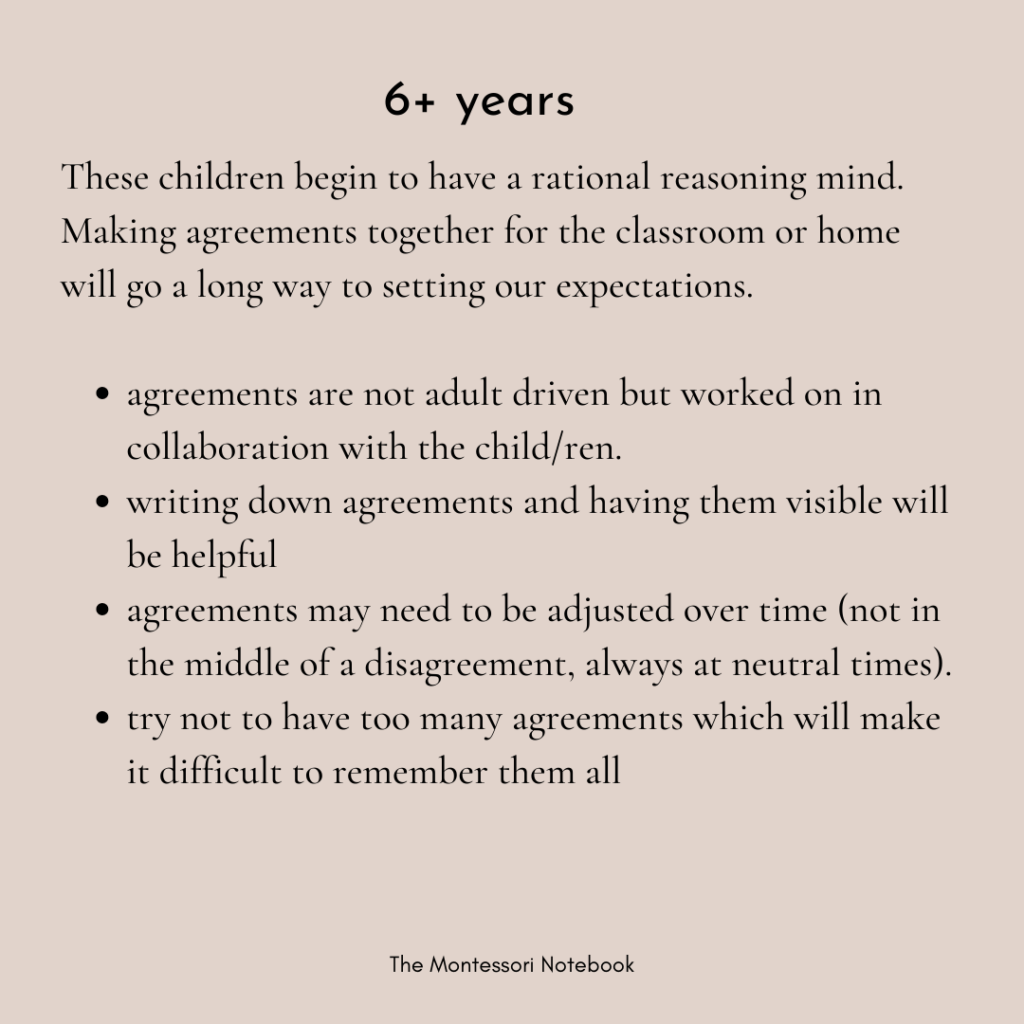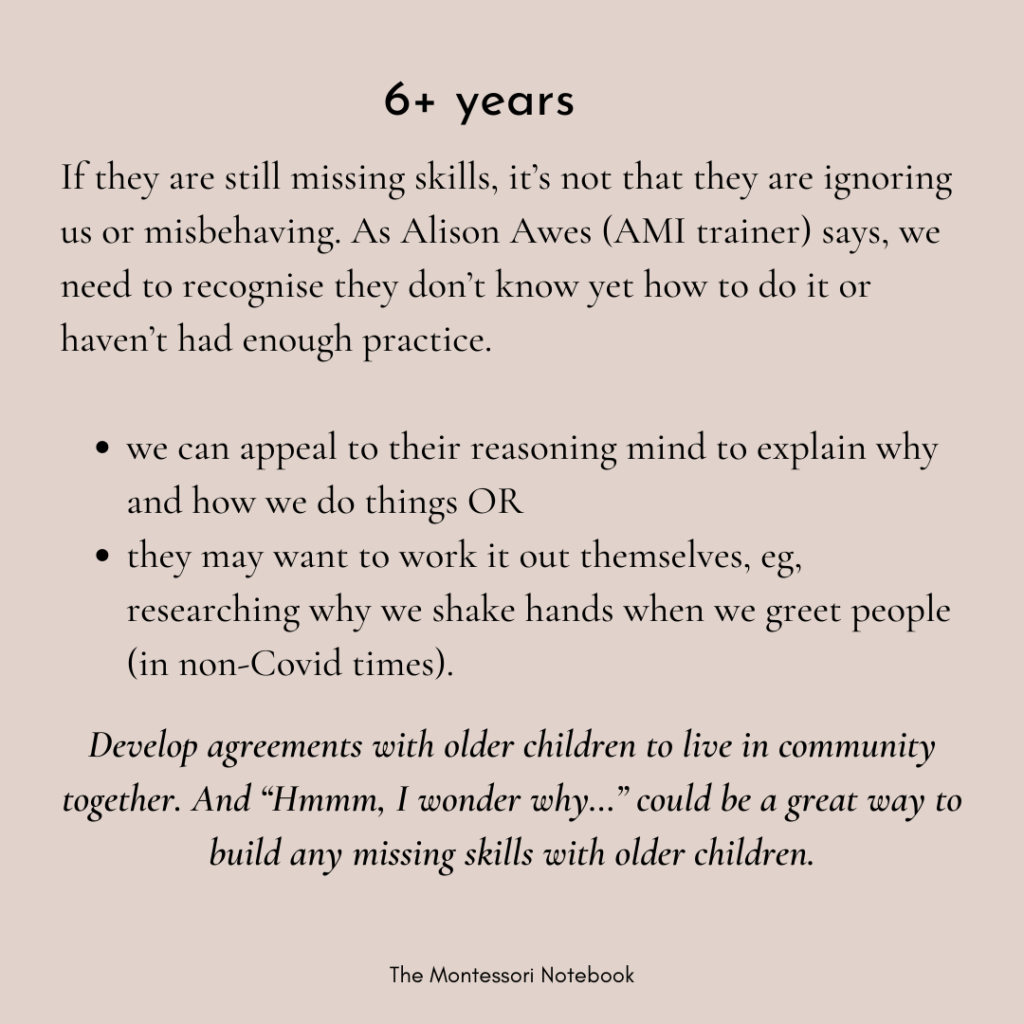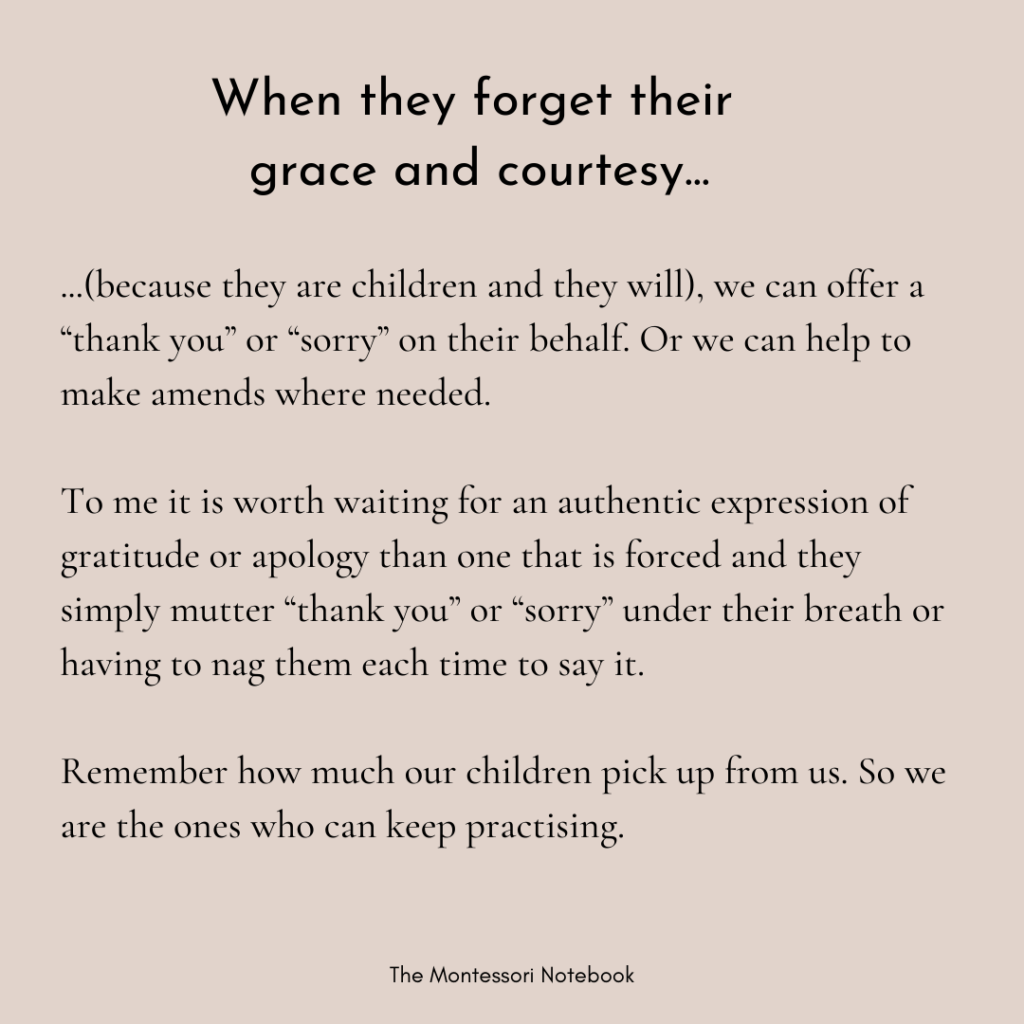Grace and courtesy – learning to say please, thank you and sorry
In Montessori you may have come across the kind of old-fashioned term “grace and courtesy.” Grace and courtesy might otherwise be known as manners but most broadly is how we teach our children what is acceptable in our society.
- How we might say please, thank you, or sorry.
- How we greet one another.
- How we respectfully interrupt someone to ask for help.
- How to take our turn to talk.
- How to push in one’s chair.
- How we excuse ourselves.
- How to listen and allowing others to finish speaking.
- And any other of the social graces we learn to be a part of our community.
Whilst we do learn grace and courtesy lessons to give to children in our Montessori training, grace and courtesy will not be the same for every family or community. Grace and courtesy will be culturally responsive. That is to say that these may differ based on which country you live in, your background, your culture, your religion etc. We can create grace and courtesy for our unique family.
Giving grace and courtesy lessons will also depend on whether we are in a classroom or in our home as well as the age of the child. In a Montessori classroom the children receive lessons like pushing in a chair, how to carry furniture, how to walk around someone’s work mat, how to close a door, or put their work back on the shelf in its place ready for the next child. Many of these will also apply at home too.
The best lessons are the ones where we have observed that our children are missing a skill that they will need. If you don’t use napkins in your home, learning to fold napkins may be of little interest to the child. Instead, look for those skills they need, like how to interrupt us if we are busy in a conversation or other.
Grace and courtesy at different ages
With children under 3 years old, they have what Dr Montessori called an unconscious absorbent mind. So our grace and courtesy lessons are not formal lessons, but by modelling the behaviour ourselves again and again.
For example, for our child to learn how to say ‘thank you’ we can say ‘thank you’ to our partner for their help or acknowledge what they have done. We can express gratitude to friends, family and of course our children when they are helpful.
Few children under 2.5/3 years old offer ‘thank you’ spontaneously. So we can say thank you on their behalf, “Thank you for the present. (showing the child) Look what your friend brought you.” or “It was thoughtful of you to offer them one of your snacks. Thank you.”
The same for our child learning to say ‘please.’ We can use it at mealtimes to ask someone to pass us something and at other moments during the day when we make requests of others.
As children under 3 are unlikely to be able to spontaneously apologise, we don’t force them in Montessori to apologise. We can model making amends – for example, offering a wet cloth or tissue if a friend has been hurt.
If we want to say sorry on our child’s behalf, we should do that. For example, thanking someone who has helped our child or saying, “I’m sorry my child hurt him/her. Are they ok? Can we do something to make it better?” We are being an example that our child is absorbing.
Whilst it is difficult, we need to trust that their unconscious absorbent mind is taking in our example and later you will hear from them authentic and spontaneous expressions of thanks, requests and apologies.
So rather than saying, “what do you say?” when we want them to say “thank you/please/sorry” instead we can model it ourselves.
Children from 3 to 6 years now have a conscious absorbent mind, so we can give a more explicit grace and courtesy lesson. For example, in a Montessori 3-6 classroom, the guide will present a grace and courtesy lesson to a small group of children or perhaps to the whole class, for example, how to welcome a visitor into the classroom. They will learn how to greet the visitor and perhaps to invite them to take a seat. Then the group will be able to practice. Sometimes there are also cards placed in the classroom for children to practice these lessons further in pairs.
In our homes then, we can make it fun to practice different scenarios that present themselves in our daily life. It might be how to close a door quietly, how to wait our turn, how to excuse ourselves. We can perhaps show them first then get them to try it or do role playing exercises if our child enjoys them.
So keep practising and these skills will become more and more natural for our children.
Older children 6+ years begin to have a rational reasoning mind. Making agreements together for the classroom or home will go a long way to setting our expectations.
These are not adult driven but worked on in collaboration with the children. Writing them down and having them visible will be helpful and the agreements may need to be adjusted over time (not in the middle of a disagreement, always at neutral times). Try not to have too many agreements which will make it difficult to remember them all.
When we observe they are still missing skills, it’s not that they are ignoring us or misbehaving. My trainer Alison Awes would say they don’t know yet how to do it or haven’t had enough practice. We can appeal to their reasoning mind to explain why and how we do things. At this age however we may find that the child doesn’t want to just be told what to do, but to work it out themselves.
They might research to find out why we shake hands when we greet people (in non-Covid times). Or if we want them to care better for their pencils, they might want to find out where pencils come from and learn then how to respect and care for them better. Imagine they leave their towels wet on the floor, perhaps they can investigate the best ways for drying towels or survey family members to put together a graph about it. At this age, the only limit is their imagination.
Develop agreements with older children to live in community together. And “Hmmm, I wonder why…” could be a great way to build any missing skills with older children.
When to give a grace and courtesy lesson
Rather than making a correction in the moment, we observe, note it down, and find a time when our children will be open to it at another neutral time. We could say, “I noticed this week that xxx (fill in the blank with what you observed). Let’s work on it together.”
Remember the Montessori mantra, “teach by teaching, not by correcting.” Our child will be more open to learning later than when they are corrected in the moment and may respond with anger, defensiveness or embarrassment.
Some examples of grace and courtesy lessons
Here are some examples we can use at home:
1. How to interrupt someone
I first saw this in my son’s Montessori preschool class (he’s now 21!). The guide asked a child waiting for her help to place their hand on her shoulder while she completed the lesson she was giving. When she was done, she thanked the child for waiting and asked how she could help them.
We can teach them the same skill (I’ve had success from children as young as 1.5 years old) that putting their hand on our shoulder means that we know they have something important to ask or tell us and we will help them as soon as we are done or there is an appropriate pause.
When they start interrupt us, we can tap our shoulder to remind them how to wait.
2. Mealtimes
Mealtimes are wonderful opportunities not just for eating food but also for conversation and off course modelling and practising grace and courtesy lessons. Have fun at meals saying “please” and “thank you” in a playful way when we ask someone to pass us something and when someone passes something to us.
- “Simone, could you please pass me the water?”
- “Thank you for offering me some of the peas.”
- “Would anyone else like the last piece of bread or would you mind if I have it?”
- “May I please leave the table?”*
- Learning to use cutlery – for babies under 1 year, I place some food on a fork and leave it in their midline for them to bring to their mouth. Then next we can introduce a spoon. Then a knife for cutting with a fork and knife.
* Everyone will have their own expectations around mealtimes, but my general rule is that children under 3 can leave the table when they are done and carrying their plate to the kitchen. I enjoy making mealtimes with children over 3 years a family occasion where we talk and enjoy each other’s company while everyone finishes.
3. Other examples
- before we are going to a birthday party we might practice saying happy birthday to the birthday child
- before a child’s birthday party practising to say “thank you” when someone gives them a gift
- before starting a board game, practise saying “better luck next time” and “congratulations” in a playful way
When they forget their grace and courtesy
And when they forget (because they are children and they will), we can offer a “thank you” or “sorry” on their behalf. Or we can help to make amends where needed.
To me it is worth waiting for an authentic expression of gratitude or apology than one that is forced and they simply mutter “thank you” or “sorry” under their breath or having to nag them each time to say it.
Remember how much our children pick up from us. So we are the ones who can keep practising.











Simone Davies has more than 20 years’ experience as an AMI Montessori educator. Simone is the author of “The Montessori Toddler” and co-author of “The Montessori Baby” and “The Montessori Child” books, comprehensive guides to raising children in a Montessori way. She currently runs parent-child Montessori classes in Amsterdam at her school Jacaranda Tree Montessori. She also has a popular blog, instagram and podcast “The Montessori Notebook” and is mother to two young adults.